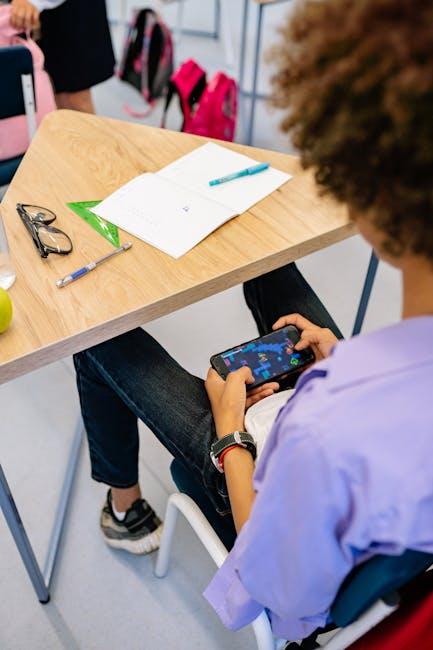In an era where the boundaries of the classroom have blurred, smartphones have emerged as powerful allies in the realm of remote learning. These pocket-sized devices, once primarily tools for communication and entertainment, now serve as gateways to education, bridging gaps of distance and accessibility. As students and educators navigate the evolving landscape of digital classrooms, smartphones offer flexibility, connectivity, and a wealth of resources at their fingertips. This article explores the multifaceted ways in which smartphones support remote learning, transforming how knowledge is accessed and shared in a connected world.
Transforming Education with Mobile Connectivity

Smartphones have revolutionized the way knowledge is accessed, making education more accessible and flexible than ever before. With a mobile device in hand, learners can engage in interactive lessons, download study materials, and join virtual classrooms from virtually anywhere. This constant connectivity breaks down geographical barriers and time constraints, empowering students to tailor their learning experiences to fit their individual schedules. Additionally, smartphones provide seamless access to a myriad of educational apps that cater to diverse learning styles-whether visual, auditory, or kinesthetic-offering personalized support and tracking progress in real-time.
Beyond individual benefits, mobile connectivity fosters a collaborative learning environment by enabling instant communication between students and educators. Features such as group chats, video calls, and shared digital workspaces encourage peer-to-peer interaction and timely feedback, enhancing engagement and motivation. Some key advantages of using smartphones for remote education include:
- On-demand access to multimedia resources
- Interactive quizzes and gamified learning
- Real-time updates and notifications
- Offline access to downloaded content
- Integration with cloud-based educational platforms
| Feature | Benefit |
|---|---|
| Video Conferencing | Live interaction with teachers and classmates |
| Push Notifications | Reminders for assignments and exams |
| Educational Apps | Customized learning experiences |
| Cloud Storage | Easy access to study materials anytime |
Enhancing Engagement Through Interactive Apps

Interactive apps transform the traditional rote learning process into an engaging, hands-on experience that keeps students motivated. These apps often incorporate elements such as quizzes, flashcards, and multimedia content that adapt to individual learning paces. By enabling real-time feedback and gamified challenges, learners find themselves more immersed and proactive in their study routines. Moreover, collaboration tools embedded within many apps foster communication among peers and educators, bridging the distance gap swiftly and efficiently.
Key features that make interactive apps effective include:
- Personalized learning paths that adapt to user progress.
- Instant feedback mechanisms for better retention.
- Social learning environments encouraging teamwork.
- Multisensory content catering to different learning styles.
| App Feature | Student Benefit | Example Usage |
|---|---|---|
| Gamification | Boosts motivation | Points and badges earned for completed lessons |
| Live Quizzing | Real-time assessment | Instant polls during virtual classes |
| Discussion Boards | Encourages questions and peer learning | Group chats and forums for topic debates |
Optimizing Learning Environments for Focus and Accessibility

Creating a productive learning environment with smartphones means rethinking traditional boundaries between focus and accessibility. These devices empower learners to tailor their study spaces with apps that block distractions and enable offline access to materials. By customizing notifications and using specialized tools such as voice-to-text or screen readers, students can effectively minimize interruptions while maximizing engagement. This balance promotes a personalized study atmosphere that supports varied learning styles and needs.
Equally important is how smartphones facilitate inclusive education through seamless adaptability. Features like adjustable text size, real-time translation, and audio descriptions break down barriers for learners with disabilities or language differences. Here’s a quick overview of key functionalities on smartphones that enhance accessibility:
- Text Magnification: Enhances readability for visually impaired users.
- Screen Readers: Converts text to speech for those with limited vision.
- Closed Captioning: Supports learners with hearing challenges.
- Language Translation Apps: Aid comprehension across diverse linguistic backgrounds.
| Feature | Benefit |
|---|---|
| Voice Commands | Hands-free control and note-taking |
| Focus Mode | Limits notifications for deep work |
| Offline Access | Studies without internet interruption |
| Customizable Fonts | Comfortable reading for every eye |
Best Practices for Integrating Smartphones into Remote Curriculum

Smartphones, when thoughtfully incorporated into remote learning, can bridge the gap between traditional education and digital accessibility. To maximize their potential, educators should focus on creating an interactive environment where these devices serve as tools for collaboration rather than distractions. This includes establishing clear guidelines for usage during lessons and leveraging apps that encourage participation, like interactive quizzes or group chats. Additionally, providing tutorials on digital literacy can empower students to navigate educational platforms independently, fostering autonomy and confidence in their virtual learning journey.
Consider the following strategies to seamlessly blend smartphones into curriculum delivery:
- Encourage app-based assignments that stimulate creativity and critical thinking.
- Design bite-sized learning modules that align with typical smartphone usage patterns.
- Promote virtual study groups through messaging apps to enhance peer-to-peer support.
- Implement regular feedback loops via quick surveys or chat polls for real-time adjustment.
| Best Practice | Impact | Ease of Implementation |
|---|---|---|
| App-based assignments | Improves engagement | Medium |
| Bite-sized content | Enhances retention | High |
| Virtual study groups | Boosts collaboration | Medium |
| Feedback loops | Increases adaptability | High |
Final Thoughts
As the lines between classrooms and living rooms continue to blur, smartphones emerge not just as devices of convenience but as vital companions in the journey of remote learning. They bridge distances, unlock information at our fingertips, and foster connections in a world that’s growing more digital by the day. While challenges remain, the adaptability and accessibility that smartphones provide underscore their role as powerful tools in reshaping education. In this evolving landscape, these ever-present devices remind us that learning knows no walls-only endless possibilities.











